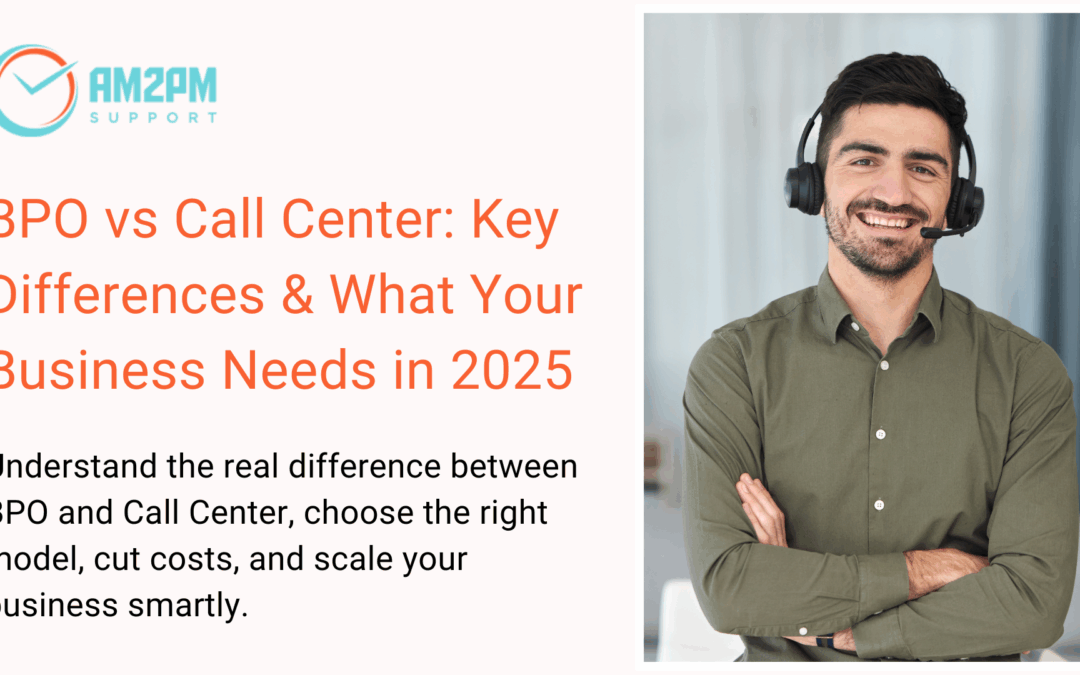You’ve probably heard people use ‘BPO’ and ‘Call Center’ as if they’re the same thing.
But are they really?
I get this question all the time. And you know what? Most people get it wrong.
Here’s the thing: While both involve outsourcing, their scope, services, and goals differ way more than you’d think. And in 2025, when you’re scaling your business, the difference between choosing a call center vs a BPO can literally make or break your growth.
By the end of this guide, you’ll know what makes them different, which one fits your business, and why it really matters right now.
Let’s start simple.
What is a BPO? (Business Process Outsourcing)

BPO means giving an outside company the job of handling your entire business functions, not just calls.
Think about it this way.
Your business has tons of moving parts, right? Customer support. Payroll processing. Data entry. Finance and accounting. HR operations. All of it.
Now, what if you could hand off entire departments to experts who do only that work? Who lives and breathes it? Who has systems, processes, and teams built specifically for it?
That’s BPO.
It’s not just about one task. It’s about outsourcing whole departments or workflows.
Struggling to manage growing call volumes?
Let AM2PM Support handle your customer calls 24/7 so you never miss a lead or opportunity again.
Types of BPO
BPOs usually work in three main areas:
- Front-office BPO: Work that deals with customers like customer support or sales.
- Back-office BPO: Work that customers don’t see like payroll, HR, and data entry.
- Knowledge Process Outsourcing (KPO): Work that needs skill and brains like analytics, research, and consulting.
The goal is simple:
👉 Do work faster and better.
👉 Save money.
👉 Let your main team focus on what they do best.
What is a Call Center?

A call center is a team that only handles customer calls either incoming (inbound) or outgoing (outbound).
That’s it. Calls only.
Now here’s the part where people get confused.
Many call centers work under a BPO. But not all BPOs are call centers.
A call center is one small part of a big BPO setup.
Types of call centers
- Inbound call center: Customers call you for help, refunds, or questions.
- Outbound call center: You call customers for sales, feedback, or reminders.
- Blended call center: You handle both incoming and outgoing calls.
So, a call center = phone calls.
A BPO = entire operations.
Differences between BPO and Call Center
Let me lay this out simply.
| Aspect | BPO | Call Center |
| Meaning | Outsource full business functions | Handle customer calls |
| Scope | HR, Finance, IT, Data, Support | Voice-based customer calls |
| Services | Front + Back-office | Inbound or Outbound calls |
| Tools Used | CRM, ERP, Automation | IVR, Telephony, CRM |
| Main Goal | Efficiency and cost-saving | Customer happiness |
| Scale | Multiple departments | More agents |
| Use Case | Outsource many functions | Manage many calls |
| Example | Customer service + Payroll | Customer support calls |
You see the difference now, right?
A BPO is playing chess. A call center is playing checkers.
Both are valuable. But they’re different games.
BPO vs Call Center: Which one does your business actually need?
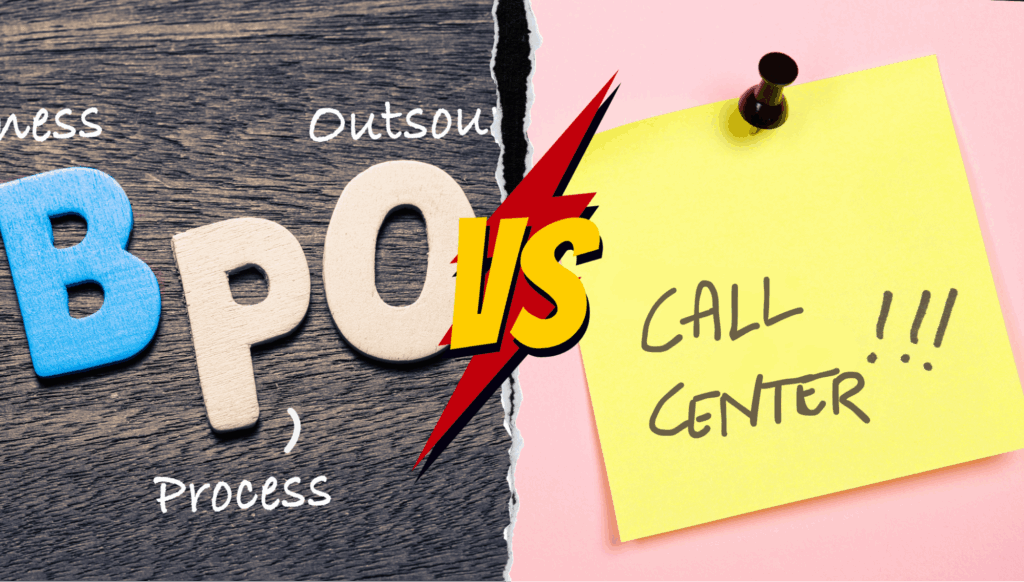
Here’s where it gets practical.
Choose a Call Center if you want to:
- Handle massive call volumes without hiring a huge in-house team
- Provide 24/7 customer support without running your operations around the clock yourself
- Run aggressive outbound sales campaigns or lead generation
- Manage seasonal spikes without permanent hiring
- Ensure every call is picked up (no more customers hanging up in frustration)
Choose a BPO if you want to:
- Outsource multiple functions at once (support + billing + data entry, for example)
- Reduce operational costs across multiple departments simultaneously
- Scale your business without scaling your internal team proportionally
- Get end-to-end business support from a single provider
- Focus your internal team only on core business strategy
Let me give you something 👇
Real examples from the businesses we’ve worked with
GoBikes (Bike rental service)
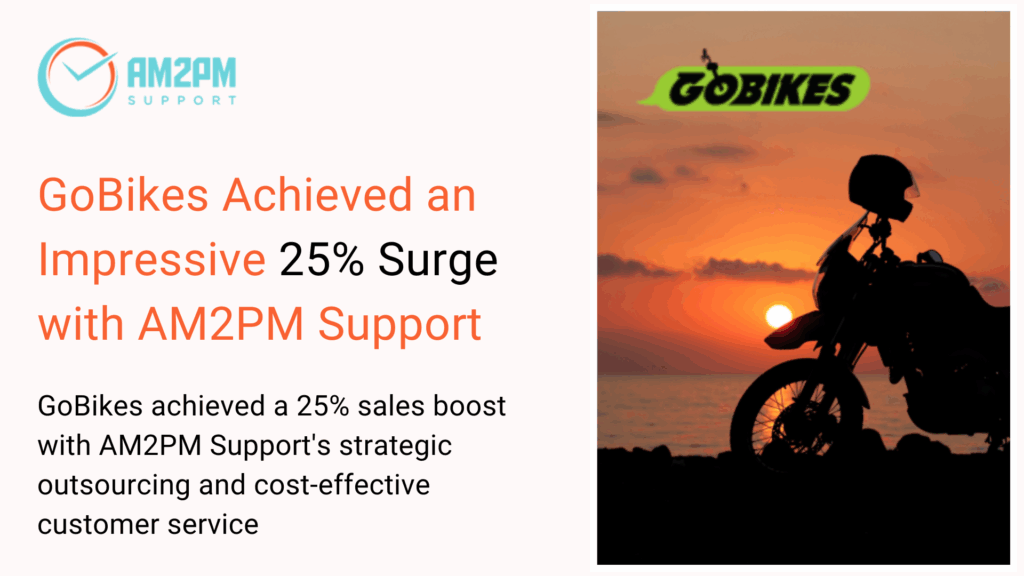
They needed call center services specifically. Why?
Because they were getting crushed by call volume. They had bikes to rent, customers wanting to book, but their team couldn’t pick up the phone fast enough.
Result? Missed sales.
We brought in a call center team. Their call pickup went from 74% to 95% in one month. Sales increased from 12% to 25%. That’s call center power.
Want to scale support without scaling costs?
Partner with AM2PM Support for flexible BPO and call center services designed for smart business growth.
Flo Mattress (Mattress brand)

They needed both.
They had customer support calls and they needed someone to manage refunds and handle billing.
So we gave them a hybrid model – part call center (inbound support), part back-office BPO (managing returns, refunds, billing).
Within 6 months? Order returns decreased by 12-15%. Hiring costs dropped by 35%. That’s BPO power.
The Artment (Home decor brand)
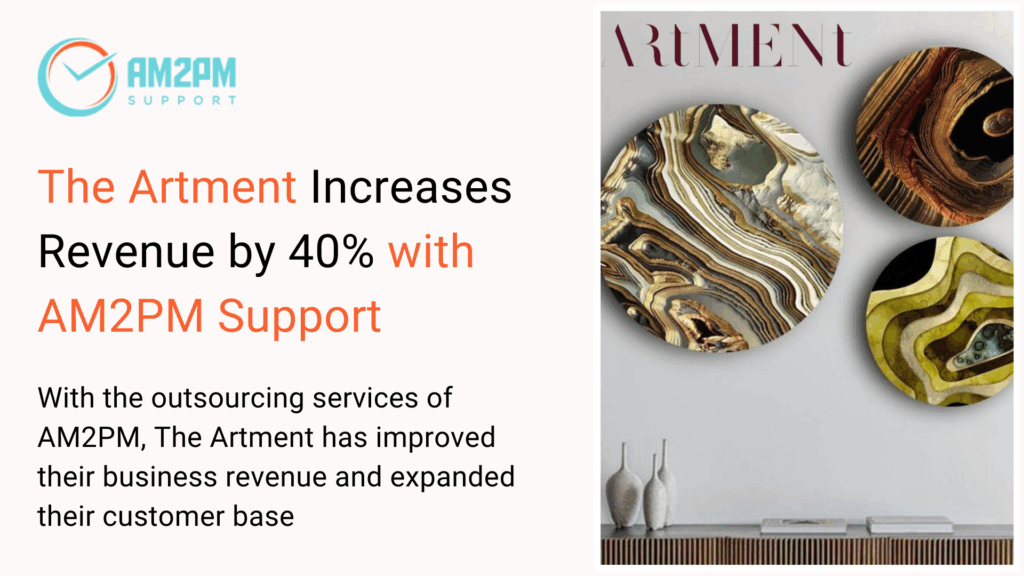
They needed a call center for inbound support and outbound agents specifically for abandoned cart calls.
Why split it? Because the skills are different.
Inbound support needs empathy and service skills. Outbound abandoned carts need sales and closing skills. We assigned different agents for each.
Result? 40% revenue increase from abandoned carts. 95% inbound call pickup. That’s the power of choosing the right model for the right job.
Too many calls, not enough hands?
Our trained agents manage your inbound and outbound calls seamlessly, saving time, stress, and money.
So here’s the question for you:
Does your business need to handle more calls efficiently? Or does your business need to overhaul multiple operational functions?
If it’s just calls → Call Center
If it’s multiple functions → BPO
Simple, right?
The Future of BPO and Call Centers in 2025

Listen, the outsourcing game is changing.
It’s not 2015 anymore. It’s not even 2020.
Here’s what’s actually happening in 2025:
AI is automating the simple stuff
Chat bots. IVR systems. Automated call routing. But you know what? They’re terrible at handling difficult customers. That’s where humans come in. So you’re seeing a hybrid model – AI handles 70% of simple inquiries, humans handle the complex ones.
Omnichannel is no longer optional
Your customers expect support via phone, chat, email, WhatsApp, social media – all of it. A good call center in 2025 isn’t just handling calls anymore. They’re handling the entire communication ecosystem.
Ready to upgrade your customer experience?
From voice to chat, AM2PM Support builds tailored contact center solutions that delight customers and boost loyalty.
Remote teams are now the default
Cloud-based operations mean your call center or BPO doesn’t need to be in the same city as you. Or even the same country. This has reduced costs while improving quality.
Data is driving decisions
Companies aren’t just “outsourcing” anymore. They’re making data-driven outsourcing decisions. How many calls per agent? What’s the ideal handle time? What’s driving customer satisfaction? All tracked, measured, optimized.
Customer Experience is beating cost-cutting
In 2025, the cheapest option always loses. Companies are competing on quality of customer experience, not just cost savings. A $0.50 cheaper agent who gives terrible service? You’ll lose 10 times that in lost customers.
The bottom line? In 2025, you need outsourcing partners who are thinking about your business, not just filling seats.
BPO vs Call Center: Pros and Cons of each model
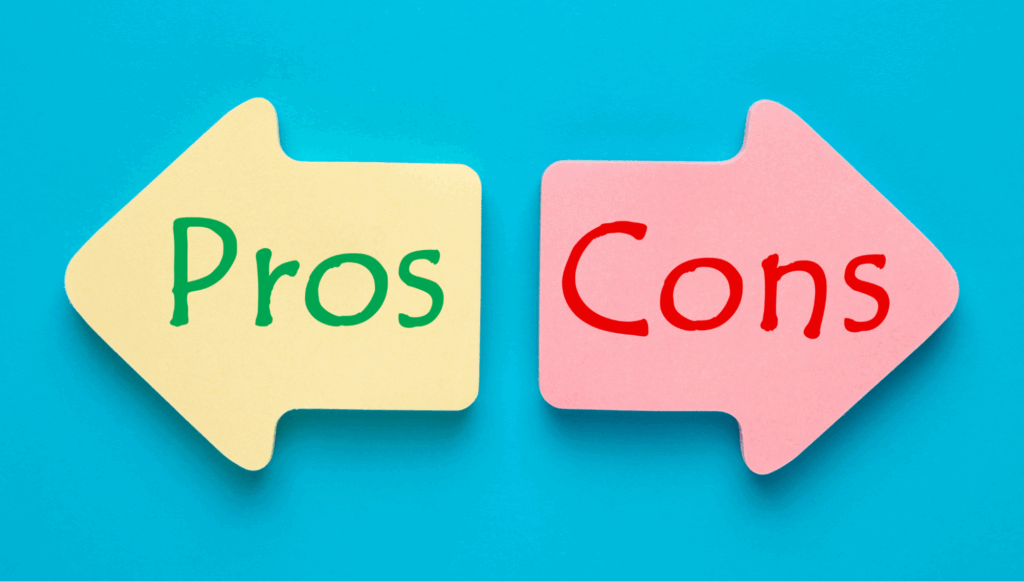
BPO pros:
✅ Scalable operations
You need more support in Q4? You scale up. Q1 comes? Scale down. No fixed overhead.
✅ End-to-end business support
One vendor handling multiple functions means consistency, coordination, and simpler management.
✅ Cost reduction per function
Instead of paying for a full HR department, a full accounting team, and a support team, you consolidate and save 30-40% across the board.
✅ Process improvement
BPO vendors bring expertise and standardized processes that often improve your operations immediately.
Calls piling up faster than you can answer?
With AM2PM Support, every call gets picked up, every query gets handled, and every customer feels valued.
BPO cons:
❌ Longer onboarding and setup
It takes time to transition multiple functions. You can’t flip a switch overnight.
❌ Complex vendor management
More moving parts means more coordination, more meetings, more potential for things to go wrong.
❌ Less flexibility for individual functions
If one function needs a change, it might affect others. You’re buying a package, not a la carte.
Call Center pros:
✅ Quick to launch
You can go from “we need support” to “calls being answered” in weeks, not months.
✅ Direct customer communication
Your voice is immediate. Problems get solved fast. Customers feel heard.
✅ Improves brand responsiveness
Nothing damages a brand like unanswered calls. A call center fixes this problem immediately.
✅ Flexible scaling
Need 5 more agents next week? You can do it. No long-term commitment is usually required.
Looking for a smarter way to handle operations?
Outsource customer support, data, and backend processes with AM2PM Support’s scalable BPO solutions.
Call Center cons:
❌ Limited to customer interactions
A call center handles calls. It doesn’t handle your accounting, your HR, your data entry. You still need to manage those separately.
❌ May not integrate with internal operations
If your internal systems aren’t set up, even a great call center can struggle to deliver value.
❌ Quality variation
Not all call centers are created equal. You can get amazing agents or mediocre ones. It depends on who you hire.
How to choose the right outsourcing partner in 2025

Okay, you’ve decided you need outsourcing. Smart move.
But here’s where most people screw up. They pick the wrong partner.
Here’s what to evaluate:
Industry expertise
Do they understand YOUR industry? A BPO that’s great with e-commerce might be terrible with SaaS. A call center great with startups might suck with enterprises. Ask about their experience. Ask for references in your industry.
Technology stack
What tools do they use? Can they integrate with your CRM? Your billing system? Your customer database? A good partner will have modern tech, not 2015 infrastructure.
Data compliance
This is non-negotiable. GDPR? ISO compliance? Data security? Make sure they’re serious about protecting your customer data. One data breach and you’re done.
24/7 support & scalability
Can they actually handle your peak periods? Can they go from 5 agents to 50 agents in 2 weeks? Ask how they handle scaling. Ask about their backup plans.
Tired of juggling calls and operations?
Leave the communication to us, AM2PM Support manages your call center while you focus on growth.
Pricing flexibility
Beware of minimum seat requirements. In 2025, good partners offer flexibility. Pay-per-minute models. Hourly outbound options. Flexible scaling without long-term contracts.
Quality assurance
How do they measure quality? Call auditing? Customer satisfaction scores? Performance tracking? A partner that doesn’t measure quality is a partner you shouldn’t trust.
Actual communication
Here’s the real test. When you talk to them, do they understand your business? Or are they just trying to sell you a package? Good partners ask questions. They listen. They customize.
The bottom line: Don’t just outsource – Outsmart

Here’s what I want you to understand.
The difference between BPO and call centers isn’t just in scope. It’s in strategy.
A call center is when you need firepower on the phones. You need speed. You need volume. You need to pick up every call and convert every opportunity.
A BPO is when you’re ready to rethink your entire operations. You’re ready to say “Our team shouldn’t be doing accounting. Our team shouldn’t be doing data entry. Our team should be doing strategy.”
The smarter you match your business goals with the right outsourcing model, the faster you scale. The faster you grow. The more you can focus on what actually matters.
And here’s the thing: Most businesses don’t need to choose between BPO and call center anymore. They need both.
You need a call center to handle customer communication 24/7. And you need BPO support to handle the backend operations that scale you faster.
That’s 2025 thinking.
So, what’s next for you: BPO or Call Center?
If you’ve made it this far, you already understand the difference between BPO and Call Center, they may sound similar, but they solve very different business problems.
So now comes the real question:
👉 What does your business actually need right now?
If your main goal is to handle customer calls efficiently, go for a Call Center.
If you want to outsource entire departments and scale your business faster, a BPO is what you’re looking for.
And if you’re smart (which I know you are 😉), you’ll use both: a Call Center to talk to your customers, and a BPO to power everything running behind the scenes.
That’s the real secret behind BPO vs Call Center success in 2025.
That’s exactly what AM2PM Support does.
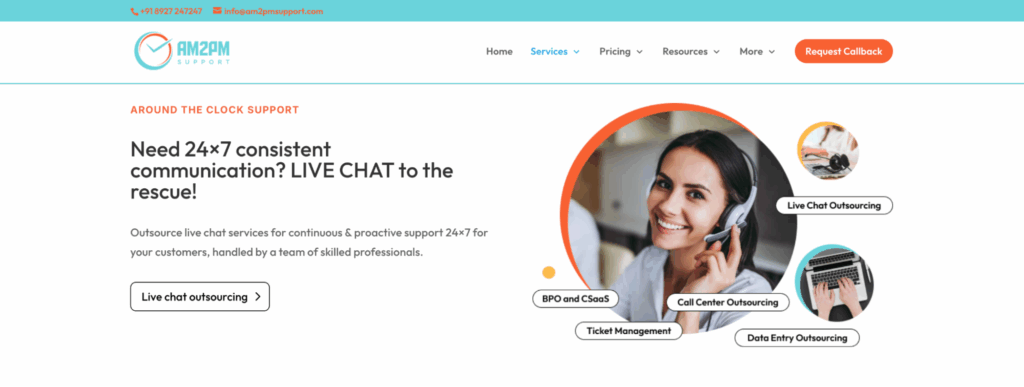
We’ve helped 150+ startups and enterprises across eCommerce, SaaS, manufacturing, hospitality, travel, and more, handling everything from inbound customer support to outbound sales campaigns and full-scale back-office BPO operations.
Here’s what that looks like in action:
- GoBikes: 74% → 95% call pickup, 12% → 25% sales jump
- Flo Mattress: 35% lower hiring costs, 15% fewer returns
- The Artment: +40% revenue from cart recovery
We don’t just fill seats, we build systems that help you scale smartly, save costs, and stay focused on growth.
And the best part?
👉 You don’t have to commit to anything massive.
👉 Start small with a Call Center team.
👉 Scale into a full BPO model when you’re ready.
👉 Stay flexible, data-driven, and fully in control.
So, if you’ve been wondering “Is BPO and Call Center the same?” or “What’s the difference between Call Center and BPO?” Now you know the truth.
They’re not the same.
They’re partners in your growth.
Book your free consultation with AM2PM Support today. No pitch. No pressure. Just a real chat about where you are, and how we can help you scale.
Because your business grows when your customers are happy. And your customers stay happy when they’re heard, supported, and taken care of, every single time.
Let’s make that happen. 🌱
Frequently asked questions about BPO and Call Center
Yes, absolutely. Most BPOs include call center services as part of their broader setup. However, a dedicated call center focuses only on voice-based customer interactions, while a BPO also manages backend operations like payroll, data entry, and accounting. Think of it this way, every call center can be part of a BPO, but not every BPO is just a call center.
Call centers are cheaper upfront because they focus on a single function, handling calls. BPOs cost more initially due to their wider scope but bring long-term savings across multiple departments. For instance, GoBikes began with a call center for quick 24/7 support, while businesses outsourcing HR, accounting, and support together save 30–40% with a BPO.
Call centers are quick, you can start answering calls in 2–3 weeks after setup and training. BPOs take longer (4–8 weeks) since they involve multiple departments and complex workflows. If speed is key, choose a call center; if you want complete operational outsourcing, invest the extra time in a BPO.
Both can scale, just differently. Call centers grow by adding agents to handle more calls within days. BPOs scale several departments at once, from support to billing to data entry. If you need quick flexibility, go for a call center; for larger business-wide scaling, a BPO works best. The Artment used both, and saw faster, smoother growth.
Inbound call centers handle incoming calls including support, complaints, or bookings. Outbound centers make calls like sales, lead generation, or follow-ups. Inbound agents need empathy; outbound agents need confidence and persuasion. If you want to serve customers better, go inbound. If you want to grow sales, go outbound.
Both must follow strict data protection laws like GDPR and ISO compliance. Always check certifications and ask tough questions: Where is your data stored? Who can access it? What’s the backup plan? A responsible vendor will answer confidently and provide documentation.
Yes, it’s the smartest path for most businesses. Start with a call center to handle immediate customer communication like calls, support, or outreach. Once you grow, shift to a BPO to add backend support and streamline multiple operations. That’s exactly how Flo Mattress and EEZYLIFE scaled successfully.

